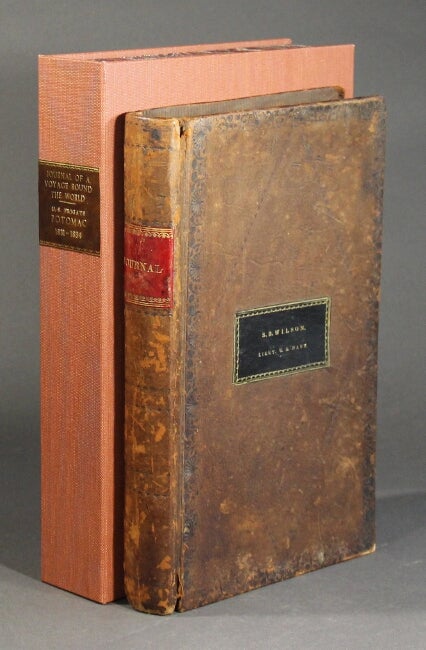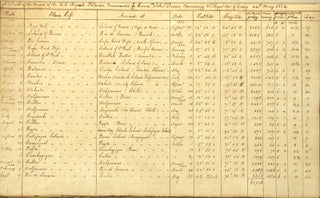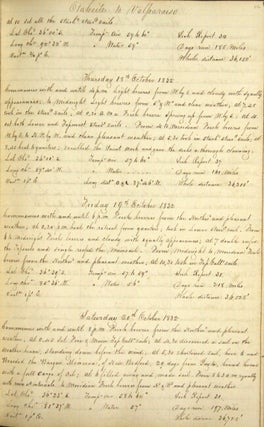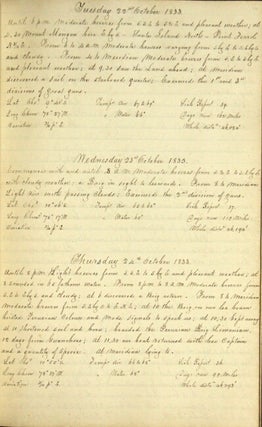Unpublished journal of Potomac’s round-the-world cruise - the first west-to-east circumnavigation of the globe by an American Navy ship - and the American attack on the Sumatran pirates of Quallah Battoo
Manuscript journal of the frigate Potomac’s round-the-world cruise
Largely shipboard and at sea: 1831-34. Folio (13" x 8½"); pp. [284]; original full calf, roll-tooled borders on covers, red morocco label on spine reading: "Journal," black morocco label on front cover reading: "S. B. Wilson. Lieut. U. S. Navy"; the binding is sound and the manuscript is in a small, neat hand, in ink; very legible. In a custom clamshell box, morocco label on spine. An unpublished manuscript journal of the maiden voyage of the U.S. frigate Potomac kept by one of her two senior lieutenants, Stephen Bayard Wilson (1795-1863) of Clermont, Columbia County, New York on the Hudson River, who first went to sea as a deckhand at the age of fourteen on a ship bound for Calcutta. Potomac, a 1726-ton frigate with a complement of 480 officers and men and armed with 42 thirty-two pounders and 8 eight-inch guns, set sail on her round-the-world cruise flying the pennant of the War of 1812 veteran Commodore John Downes. Downes’ original orders did not include a circumnavigation of the globe. He was to deliver Martin Van Buren to England as the American Minister to that country, then proceed via Rio de Janeiro and Cape Horn to Valparaiso where he was to assume command of United States Naval Forces in the Pacific. However, news of the plundering of Salem merchant ship Friendship and the murder of several of her crew in February 1831 by Sumatran natives of Quallah Battoo persuaded President Andrew Jackson to instead redirect the Potomac to "repair at once to Sumatra, by way of the Cape of Good Hope" to atone for this "wanton outrage" – making this the earliest overt example of Gunboat Diplomacy in American history. Potomac would return to Boston three years later having become the first ship in the United States Navy to circumnavigate of the globe from West to East. Wilson’s remarks are kept in a journal format, more of a diary than a proper seaman's log. There are no pages dedicated to 24 hours of recorded speeds, wind direction, or courses sailed, etc. (although these pieces of information are often duly recorded in the daily narrative). It’s easy to read, understand, and track the voyage day to day. On 26 August 1831, the date the ship weighed anchor and sailed from New York, Lieutenant Wilson records a "List of officers attached to the U. S. Frigate Potomac on her departure from New York the 26th August 1831." Included are Commodore John Downes, Lieutenants Irvine Shubrick, Stephen B. Wilson, Reuben R. Pinkham, Henry Hoff and Jonathan Ingersoll, Asst. Surgeon Jonathan M. Foltz, Schoolmaster Francis Warriner, and Sailing Master Benjamin Totten, a supernumerary en route to join the schooner Dolphin in the Pacific. Lieutenants Shubrick and Wilson were the two senior lieutenants sharing the same date of promotion to that rank on 13 January 1825. Lieutenant Wilson, the author of the journal, rose to rank of Captain in 1855 and died in 1863. Lieutenant Hoff rose to the rank of Rear Admiral in 1867. Of the remaining lieutenants none rose above the rank of commander. The journal opens with a single page containing an abstract log of the entire voyage from leaving New York on 26 August 1831 to arriving in Boston on 23 May 1834, continues with Lieutenant Wilson’s orders to report to the Potomac and follows with 3 years of day-by-day descriptions of occurrences including reports of weather, shipboard activities, sail handling and navigation, visits with, or mentions of, ships met (including many whalers, usually giving vessel name, home port, months at sea and amount of oil), provisioning and watering, official and ceremonial visits, deaths, etc. The Potomac sailed from New York to the Cape Verde Islands, then proceeded to Rio de Janeiro, St. Paul, Quallah Battoo (Sumatra), Batavia (Java), Macao, Canton, Oahu, Tahiti, Callao, Valparaiso, Coquimbo, Callao, Paita, the Galapagos Islands, Paita, Callao, Valparaiso, Rio de Janeiro and ended in Boston. In all, over the course of her 3-year journey, the Potomac traveled 61,816 miles. The attack on the natives of Quallah Battoo occurs early in this journal, and is described in considerable detail, beginning with the dispatch and initial approach of an American landing party on February 6, 1832. Lieutenant Wilson writes, “at 9 the Expedition returned from the shore, having destroyed the Forts and left the Town in flames, and bringing the bodies of Wm P. Smith, sea[man], killed, and Benjn T. Brown, Marine killed, together with the following wounded… [a list of 8 men follows]. He goes on to describe the bombardment by “Potomac’s” guns two days later, completing the destructive work of the landing party, and leaving the entire settlement in flames ... At 2 [pm] observed the Forts on shore had hoisted White Flags…” On February 9, an emissary from the settlement came aboard to discuss “a cessation of Hostility.” After the battle, the Americans remained in the vicinity for several more days, taking on wood and water and performing maintenance, until their departure for Batavia on February 18th. In all, Wilson writes about 1750 words covering their engagement at Quallah Battoo. The Dictionary of American Naval Fighting Ships states, "Of the 282 sailors and Marines who landed, two were killed while 150 natives, including the village chieftain, Po Mahomet, died for their piracy." Potomac arrived in Batavia at the end of March, then proceeded to Macao, arriving in mid-May. After taking on fresh provisions and visiting Canton, they sailed for Hawaii, reaching Woahoo (Oahu) by the end of July, where they received King Kamehameha on board. On August 5, Wilson writes, "Received a visit from His Majesty Tamehameha 3rd, King of the Sandwich Islands and suite, Saluted him with 21 Guns." (This, incidentally, was the first entertainment of royalty aboard a U. S. Navy ship.) In recognition of the honor, King Kamehameha presented the Potomac with 40 hogs. From Hawaii, they went on to Tahiti and, on September 19, "the Queen Dowager of the Island visited the ship." Then on to the west coast of South America – Callao, Valparaiso, the Galapagos, and other ports, where they met numerous American whale ships and sealers – including Nathaniel Brown Palmer’s Annawanda, as well as many international naval and merchant vessels. On December 16, at Callao, Wilson notes, "arrived the Whaling Ship Catharine of Salem, 16 days out of Valparaiso; the ship is now under the charge of the Chief Mate, her former Captain, Paddock, having, when in the state of derangement, stabbed several persons in the streets of Valparaiso; two of whom (his friends) were instantly killed; for this he was condemned to be shot and hung, which was carried into execution while he was still in such a sick state as to be unconscious of having committed a crime." They remained on this station until February, 1834, when they rounded Cape Horn where they dodged "Several icebergs ... one about a mile in circumference and 200 feet high". It was a sufficiently noteworthy cruise to be the subject of two full-length books, one by Francis Warriner, a schoolmaster on the Potomac, and another by Jeremiah Reynolds, who joined the “Potomac” mid-cruise as secretary to Commodore John Downes. Both books were published to popular acclaim in 1835, and both devote chapters to the Quallah Battoo incident. As one might expect, both reports view the engagement favorably. They provide details against which Wilson’s account can be checked, and Wilson’s account, in turn, adds new details and an immediacy to the action. Several others of those on board were also future authors. Surgeon Foltz’s journal was published in the first several chapters of his biography, Surgeon of the Seas, written by his son and published in Indianapolis in 1931. Purser Philo White, who joined the ship as purser at Valparaiso in February 1834, wrote a narrative of his later cruise with Thomas ap Catesby Jones as purser of the sloop of war Dale during the war with Mexico, a journal that was only recently published by the Old West Publishing Company of Denver in 1965. Finally, Sailing Master Benjamin Totten published a professional work for midshipmen in 1841, Naval Text-Book. Letters to the Midshipmen of the United States Navy on Masting, Rigging, and Managing Vessels of War (Boston, Charles C. Little and James Brown). As well as relating major historical events that took place during this cruise, Wilson’s narrative gives us an accurate and highly-detailed sense of the daily lives and adventures of officers and men on a prolonged naval mission. One of the more notable aspects of the voyage is the attention paid to the 25 men who died during the voyage – from accidents (many of which are described), insanity and suicide, illnesses such as dysentery, and more bizarre maladies such as "strangulated intestines," not to mention attacks on small defenseless villages on Sumatran islands. Item #59179
Price: $25,000.00






